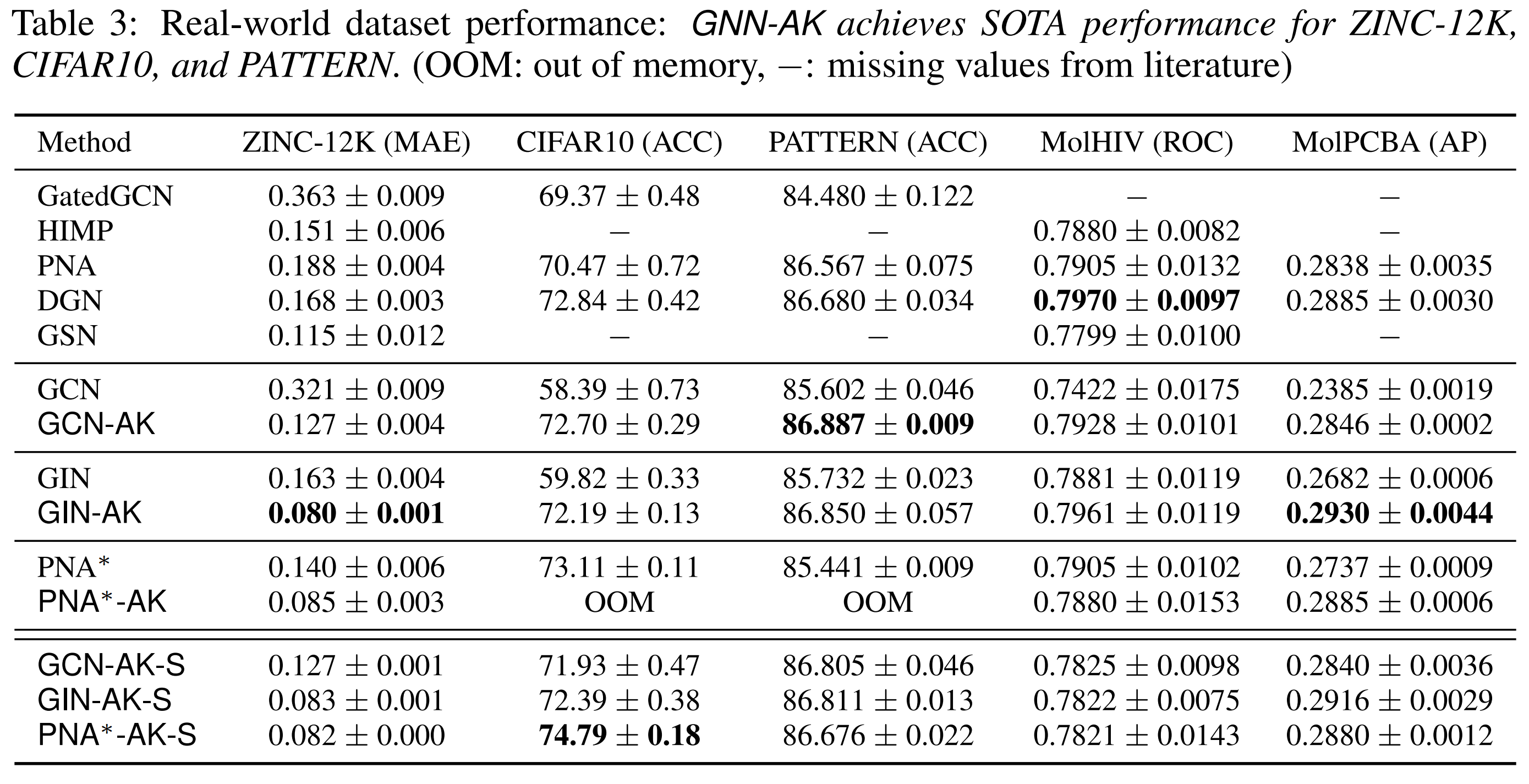Official code for From Stars to Subgraphs: Uplifting Any GNN with Local Structure Awareness
# params
# 10/6/2021, newest packages.
ENV=gnn_ak
CUDA=11.1
TORCH=1.9.1
PYG=2.0.1
# create env
conda create --name $ENV python=3.9 -y
conda activate $ENV
# install pytorch
conda install pytorch=$TORCH torchvision torchaudio cudatoolkit=$cuda -c pytorch -c nvidia -y
# install pyg2.0
conda install pyg=$PYG -c pyg -c conda-forge -y
# install ogb
pip install ogb
# install rdkit
conda install -c conda-forge rdkit -y
# update yacs and tensorboard
pip install yacs==0.1.8 --force # PyG currently use 0.1.6 which doesn't support None argument.
pip install tensorboard
pip install matplotlib
core/ contains all source code.
train/ contains all scripts for available datasets.
- Subgraph extraction is implemented as data transform operator in PyG. See
core/transform.py. The transform layer will built the mapping from original nodes and edges to all subgraphs. - The mappings are used directly in
GNN-AK(+)to online build the combined subgraphs for each graph, seecore/model.py. (For each graph with N node, N subgraphs are combined to a gaint subgraph first. Then for batch, all combined gaint subgraphs are combined again.) - SubgraphDrop is implemented inside
core/transform.py, see here. And the usage incore/model.py. core/model_utils/pyg_gnn_wrapper.pyis the place to add your self-designed GNN layer X and then use X-AK(+) on fly~
See core/config.py for all options.
See core/model_utls/pyg_gnn_wrapper.py for more options.
Custom new GNN convolutional layer 'X' can be plugged in core/model_utls/pyg_gnn_wrapper.py, and use 'X' as model.gnn_type option.
# Run different normal GNNs
python -m train.zinc model.mini_layers 0 model.gnn_type GINEConv
python -m train.zinc model.mini_layers 0 model.gnn_type SimplifiedPNAConv
python -m train.zinc model.mini_layers 0 model.gnn_type GCNConv
python -m train.zinc model.mini_layers 0 model.gnn_type GATConv
python -m train.zinc model.mini_layers 0 model.gnn_type ...
python -m train.zinc model.num_layers 6 model.mini_layers 0 model.gnn_type GCNConv # 6-layer GCN
See all available datasets under train folder.
# Run different datasets
python -m train.zinc
python -m train.cifar10
python -m train.counting
python -m train.graph_property
python -m ...
Fully theoretically explained by Subgraph-1-WL*.
Use: model.mini_layers 1 (or >1) model.embs "(0,1)" model.hops_dim 0
python -m train.zinc model.mini_layers 1 model.gnn_type GINEConv model.embs "(0,1)" model.hops_dim 0
At least as powerful as GNN-AK (or more powerful).
Use: model.mini_layers 1 (or >1) model.embs "(0,1,2)" model.hops_dim 16
These are set as default. See core/config.py.
# Run GNN-AK+ with different normal GNNs
python -m train.zinc model.mini_layers 1 model.gnn_type GINEConv # 1-layer base model
python -m train.zinc model.mini_layers 1 model.gnn_type SimplifiedPNAConv # 1-layer base model
python -m train.zinc model.mini_layers 2 model.gnn_type GINEConv # 2-layer base model
python -m train.zinc model.mini_layers 2 model.gnn_type SimplifiedPNAConv # 2-layer base model
Changing number of outer layers.
python -m train.zinc model.num_layers 4
python -m train.zinc model.num_layers 6
python -m train.zinc model.num_layers 8
See core/transform.py for detailed implementation.
python -m train.zinc subgraph.hops 2 # 2-hop egonet
python -m train.zinc subgraph.hops 3 # 3-hop egonet
# Run with random-walk subgraphs based on node2vec
python -m train.zinc subgraph.hops 0 subgraph.walk_length 10 subgraph.walk_p 1.0 subgraph.walk_q 1.0
See option sampling section under core/config.py.
Change sampling.redundancy(R in the paper) to change the resource usage.
python -m train.zinc sampling.mode shortest_path sampling.redundancy 1 sampling.stride 5 sampling.batch_factor 4
python -m train.zinc sampling.mode shortest_path sampling.redundancy 3 sampling.stride 5 sampling.batch_factor 4
python -m train.zinc sampling.mode shortest_path sampling.redundancy 5 sampling.stride 5 sampling.batch_factor 4
python -m train.cifar10 sampling.mode random sampling.redundancy 1 sampling.random_rate 0.07 sampling.batch_factor 8
python -m train.cifar10 sampling.mode random sampling.redundancy 3 sampling.random_rate 0.21 sampling.batch_factor 8
python -m train.cifar10 sampling.mode random sampling.redundancy 5 sampling.random_rate 0.35 sampling.batch_factor 8
## Note: sampling.random_rate = 0.07*sampling.redundancy. 0.07 is set based on dataset.
Please cite our work if you use our code!
@inproceedings{
zhao2022from,
title={From Stars to Subgraphs: Uplifting Any {GNN} with Local Structure Awareness},
author={Lingxiao Zhao and Wei Jin and Leman Akoglu and Neil Shah},
booktitle={International Conference on Learning Representations},
year={2022},
url={https://openreview.net/forum?id=Mspk_WYKoEH}
}



